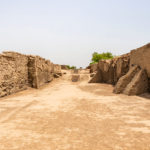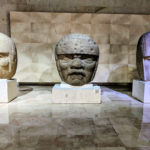1Cradles of Civilization
A cradle of civilization is a place where civilization appears. The domestication of plants and animals resulted in major changes in human society. First, humans changed from a hunting and gathering to a farming society. In turn, this resulted in better food supplies and population growth. Finally, the growth lead to the rise of cities. Six cradles of civilization developed. They developed independently of one another.
Social Changes
City life went through many changes. Social classes and specialized labor emerged. Writing created a literate society. Architecture advanced with the building of monuments and public buildings. Society changed from stone to metal tools.
[Click on the images to see a larger full-sized image]
2Mesopotamia: 5000 BC
Mesopotamia developed between the Tigris and Euphrates Rivers. This farming region established many small towns. The very first town was Eridu. Eridu appeared about 5000 BC. The town was more than just homes. A town provided the ability to build canals and irrigation systems. This resulted in more food production. And, that lead to population growth. As the population grew human life became more complex. Spiritual belief developed further. Temples and sacred areas were at the heart of the town. Sometimes, temples were located on the pyramids. The Great Ziggurat is such a pyramid.
Growth of Cities as Trading Centers
By 3500 BC the small towns in Mesopotamia grew into cities. These cities were centers of trade and agriculture in the region. Trade included lumber, metals, and grains. The wheel, mathematics and cuneiform writing emerged in Mesopotamia.
3Ancient Egypt: 4000 BC
Egypt was the second cradle of civilization. By 4000 BC small farm settlements grew up along the Nile River. Small kingdoms ruled over these settlements. By 3000 BC, the farming settlements developed into towns. Eventually, the many kingdoms were unified into one kingdom in 3100 BC.
Rise of Social Classes
The town of Nekhen became a major trading center on the Nile. As it grew larger, society became more complex. A ruler stood at the top of society. Sometimes, rulers were living gods. A class of officials and priests were beneath the ruler. Craftsmen and warriors were the next social layer. Finally, the commoners were at the bottom.
4Ancient India: 3000 BC
The civilization of Ancient India developed along the Indus River. The settlements were located in parts of India, Pakistan and Afghanistan. The Indus River provided rich alluvial soils and water needed for agriculture.
Town Planning
Mohenjo Daro was one of the largest cities in the Indus civilization. The city was built in rectangular grids. A market place stood at the city center. Rectangular grids of homes and roads mark the city. A covered drainage system ran down the main roads. Hundreds of wells were located throughout the city. Mohenjo Daro provided a good supply of water. In addition, drainage systems got rid of waste water and sewage. Further, the city had granaries for food storage and public buildings. The city was very advanced.
5.Ancient China: 2000 BC
By 5000 BC small farm villages appeared in China. Rice, millet and hemp were domesticated crops. Pigs and buffaloes were also raised. Most of this growth occurred around the Yellow River. By 2500 BC walled settlements were in place. These settlements were making metal tools.
The Bronze Age
Unification of these settlements took place in 1600 BC. The Yellow River region was now part of the Shang state. The Shang believed that their ruler had divine powers from his ancestors. Classes of priests, craftsmen, and warriors existed. The Shang state entered the Bronze Age. It also developed a writing system and calendar.
6Ancient Peru: 3000 BC
Early farming began in Peru about 4700 BC. It is thought that construction of canals took place around 3500 BC. At the same time, settlements began to appear. Caral was the first city in the region. It was also the largest in Americas. However, by 3100 BC many other larger settlements sprang up along three major rivers in Peru. These settlements made up the Norte Chico civilization. Cotton and maize were major crops. Fish from coastal settlements were also important.
Government
The development of a central government was needed to manage these settlements. It is thought that the civilization was theocratic. This meant that they were governed by a religious class. Evidence for this is the construction of large monuments and warehouses. Their construction would require a high level of central control.
7Ancient Mesoamerica: 1500 BC
Early farming took place as early as 5000 BC. However, maize was domesticated in 2700 BC. During this period small farming settlements began to appear. The Olmec civilization rose in 1500 BC. This was located in the Coatzacoalcos River basin in Mexico. Conditions were similar to the other cradles of civilization. Fertile soil, water and domesticated crops resulted in population growth. San Lorenzo was the first Olmec city to emerge. La Venta became the major city by 900 BC. Pyramid structures and colossal heads also appeared in this time.
Environmental Change
By 400 BC, the Olmec civilization began to decline rapidly. No single reason can explain this. A number of theories are proposed. One theory suggests changes in the flow of the rivers that affected agriculture. Another theory suggests volcanic activity that forced the people to leave. Lastly, the civilization caused rivers to silt up and make the lands unsuitable for farming.







